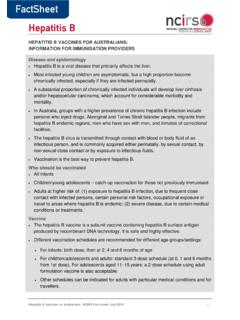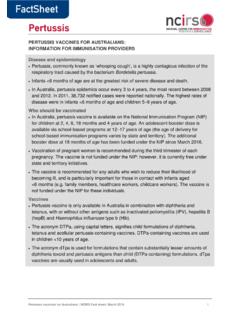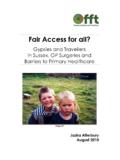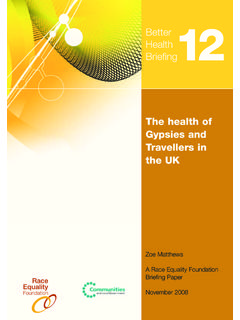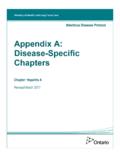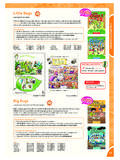Transcription of [Type text] Meningococcal vaccines
1 [Type text] Meningococcal vaccines for Australians | NCIRS Fact sheet: August 2018 1 Meningococcal vaccines Meningococcal vaccines FOR AUSTRALIANS: INFORMATION FOR IMMUNISATION PROVIDERS This fact sheet provides information for immunisation providers on Meningococcal disease and the use of Meningococcal vaccines in Australia. It can be used in conjunction with the NCIRS fact sheet Meningococcal vaccines frequently asked questions to facilitate discussions with parents or other individuals considering receiving Meningococcal vaccines . Disease and epidemiology Meningococcal disease is a rare but serious infection caused by the bacterium Neisseria meningitidis (N. meningitidis). There are 13 serogroups. Meningococcal disease is most commonly caused by serogroups A, B, C, W and Y. Septicaemia and/or meningitis are the most common clinical manifestations of invasive Meningococcal disease (IMD). The highest incidence of Meningococcal disease is in children aged <2 years and adolescents aged 15 19 years.
2 Carriage rates of the bacteria are highest in older adolescents and young adults. The incidence of Meningococcal disease fluctuates naturally over time. Meningococcal B disease has been dominant until recently, but has been naturally declining in most states and territories, even in the absence of widespread vaccination against this serogroup. The incidence of Meningococcal W disease has increased since 2013. In 2017, serogroups B and W caused similar numbers of Meningococcal disease cases in Australia ( and , respectively, of cases with an identified serogroup). Meningococcal B disease remains the most common cause of IMD in children, adolescents and young adults. Meningococcal W and Y disease occurs over a more diverse age range and may present with less typical clinical manifestations than disease due to other serogroups. vaccines Three types of Meningococcal vaccines are available in Australia: recombinant Meningococcal B (MenB) vaccines : Bexsero , Trumenba quadrivalent (A, C, W, Y) Meningococcal (MenACWY) conjugate vaccines : Menactra , Menveo , Nimenrix Meningococcal C (MenC) conjugate vaccine: Menitorix (combination formulation with the Haemophilus influenzae type b (Hib-MenC) vaccine), NeisVac-C (monovalent Meningococcal C vaccine) Who should be vaccinated People in age groups with increased incidence of IMD or high carriage rates of N.
3 Meningitidis: Infants and young children aged <2 years: All infants and children aged <2 years are recommended to receive MenACWY vaccine. A routine single dose of MenACWY vaccine at 12 months of age is recommended and funded under the National Immunisation Program (NIP). MenACWY vaccine is available for infants <12 months of age through private prescription from 6 weeks of age, and requires more doses. MenB vaccine (Bexsero only for this age group) is also recommended but not funded under the NIP for children aged <2 years. Adolescents and some young adults: All adolescents aged 15 19 years are recommended to receive MenB and MenACWY vaccines . Some young adults aged 20 24 years who live in close quarters (such as new military recruits and students living in residential accommodation) or who are current smokers are also recommended to receive vaccination. In some Australian states, vaccines are funded for certain age groups in response to locally predominant Meningococcal B or W disease (refer to Table 1).
4 Meningococcal vaccines for Australians | NCIRS Fact sheet: August 2018 2 Aboriginal and/or Torres Strait Islander people: Aboriginal and Torres Strait Islander people aged 2 months to 19 years are recommended to receive MenB and MenACWY vaccines . People with medical conditions associated with an increased risk of IMD: People with complement disorders, asplenia and other immunocompromising conditions are recommended to receive MenB and MenACWY vaccines . Travellers: People travelling to certain destinations where there is an increased risk of exposure to serogroups A, C, W or Y (including, but not limited to, the meningitis belt of sub-Saharan Africa) are recommended to receive MenACWY vaccine. Vaccination is required for pilgrims attending the annual Hajj in Mecca, Saudi Arabia. People who have occupational risk: Laboratory personnel who frequently handle Neisseria meningitidis should be vaccinated with MenB and MenACWY vaccines . Anyone wishing to reduce their risk of IMD: Vaccination with MenB and MenACWY vaccines may be offered to anyone aged >6 weeks (refer to Table 1).
5 Table 1: Meningococcal vaccines available for use in Australia and current access/availability Trade name Formulation Provides protection against serogroup: Current access/availability as of July 2018 A B C W Y Recombinant Meningococcal B (MenB) vaccines Bexsero Recombinant multicomponent MenB * MenB vaccine available nationally through private prescription (Trumenba can only be used for people aged 10 years). Bexsero available for free in South Australia to students in years 10, 11 and 12 through the B Part of It study in 2017 2018. Bexsero available in South Australia through a state-funded program for infants aged 6 weeks to 12 months (commencing October 2018) with a catch-up program for those aged 12 months to <4 years (until December 2019). MenB vaccine will be funded in South Australia for an ongoing Year 10 school program (commencing February 2019) and for adolescents/young adults aged 17 to <21 years (February to December 2019). Trumenba Recombinant bivalent fHBP MenB * Quadrivalent Meningococcal (MenACWY) conjugate vaccines Menactra Quadrivalent diphtheria toxoid conjugate Nimenrix NIP-funded for single dose at age 12 months.
6 All brands available through private prescription. Available through state-funded programs in six states and territories (New South Wales, Victoria, Queensland, Tasmania, Western Australia and the Australian Capital Territory) for some adolescents. Funded vaccine is also available for specific populations (based on age and/or region of residence) in Tasmania, Western Australia and Nothern Territory. Local outbreak responses in some areas of Northern Territory and South Australia are underway. Menveo Quadrivalent CRM197 conjugate Nimenrix Quadrivalent tetanus toxoid conjugate Meningococcal vaccines for Australians | NCIRS Fact sheet: August 2018 3 Meningococcal C (MenC) conjugate vaccines Menitorix Hib MenC conjugate combination Combination Hib MenC conjugate vaccine at 12 months of age replaced by MenACWY vaccine (Nimenrix) and monovalent Hib (Act-HIB) on the NIP from 1 July 2018. Monovalent MenC vaccine available on the NIP for those requiring catch-up of the 12-month childhood dose (when they are not eligible to receive MenACWY vaccine).
7 Menitorix also serves as a booster dose of Hib vaccine NeisVac-C Monovalent MenC conjugate * There are many strains of serogroup B meningococcus. Laboratory tests indicate that both MenB vaccines are likely to protect against a large proportion (>75%) of MenB strains in Australia, but there is as yet inadequate information regarding the exact proportion or any difference between the two vaccines . Refer to Table 4 for dosing guidelines. Refer to state and territory health department websites. Funded doses of Bexsero for this age group in South Australia are provided through a population-level study assessing the impact of the vaccine on nasopharyngeal carriage of N. meningitidis and herd Vaccine brands are registered for use in different age groups (refer to Table 3). Table 2: People and age groups strongly recommended to receive Meningococcal vaccination Population 6 weeks 23 months 2 4 years 5 14 years 15 19 years 20 24 years 25 years Healthy Aboriginal or Torres Strait Islanders MenB MenACWY MenB MenACWY MenB MenACWY MenB MenACWY Healthy Non-Indigenous MenB MenACWY MenB MenACWY Increased medical risk* MenB MenACWY MenB MenACWY MenB MenACWY MenB MenACWY MenB MenACWY MenB MenACWY People living in close quarters MenB MenACWY MenB MenACWY Current smokers MenB MenACWY MenB MenACWY Occupational risk# MenB MenACWY MenB MenACWY MenB MenACWY Travellers MenACWY MenACWY MenACWY MenACWY MenACWY MenACWY * Includes those with a specified medical condition associated with increased risk of Meningococcal disease, including inherited defects or deficiency of properdin or complement components, current or future treatment with eculizumab, functional or anatomical asplenia.
8 HIV infection and haematopoetic stem cell transplant. Includes students living in residential accommodation and new military recruits. # Includes laboratory personnel who are at occupational risk of exposure to Neisseria meningitides. People (age 6 weeks) who are travelling to areas where Meningococcal disease is more common and there is an increased risk of exposure to Meningococcal serogroups A, C, W, or Y disease. Meningococcal vaccines for Australians | NCIRS Fact sheet: August 2018 4 The disease Meningococcal disease is a relatively rare but serious infection caused by the bacterium Neisseria meningitidis, commonly known as the meningococcus. There are 13 serogroups, distinguished by differences in the surface polysaccharides of the organism s outer membrane capsule. Globally, most cases of Meningococcal disease are caused by serogroups A, B, C, W and Y. Currently, even with antibiotic treatment, the mortality rate for Meningococcal disease is around 5 10%.
9 About 10 30% of children and adolescents who survive the disease develop permanent complications such as limb deformity, skin scarring, deafness and neurological Clinical features Invasive Meningococcal disease (IMD; defined by isolation of meningococci from body sites that are normally sterile) most commonly manifests as septicaemia and meningitis. Typical symptoms are often non-specific and can include sudden onset of fever, a rash that can be petechial or purpuric (like red-purple spots or bruises) or maculopapular (a flat or raised non-specific rash), headache, neck stiffness, photophobia, altered consciousness, muscle aches, joint pain, nausea and , 5-7 Other less common manifestations of Meningococcal disease include pneumonia, arthritis, epiglottitis, pericarditis and , 6, 8 Primary Meningococcal conjunctivitis may precede invasive Not all symptoms or signs may be present at disease onset. The characteristic rash of Meningococcal disease (a rash which does not disappear with gentle pressure on the skin) is not always present.
10 Meningococcal W disease, in particular, has been associated with higher rates of atypical presentations in up to 20% of Transmission Meningococci are carried and transmitted only by humans. Individuals within a population can carry meningococci in their throat and/or nose. The prevalence and duration of carriage varies over time and in different populations and age groups, with peak carriage rates (>20%) occurring in Smokers have increased carriage rates12-14 which may increase transmission and invasive disease. Meningococcal bacteria are transmitted via respiratory droplets. The risk of acquiring infection is increased by regular, prolonged close contact, such as living in the same household or intimate kissing. The disease has an incubation period of 1 10 days, most commonly 3 4 days. Risk factors for acquiring the disease People who are immunocompromised due to certain disorders of the immune system (particularly complement deficiencies), certain medical treatments, or functional or anatomical asplenia have an increased risk of acquiring the disease.
